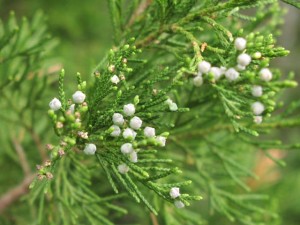Juniperus virginiana its common names include red cedar, eastern red-cedar, eastern redcedar, eastern juniper, red juniper, pencil cedar, and aromatic cedar — is a species of juniper native to eastern North America from southeastern Canada to the Gulf of Mexico and east of the Great Plains.
Contents
Uses
The fine-grained, soft brittle pinkish- to brownish-red heartwood is fragrant, very light and very durable, even in contact with soil. Because of its rot resistance, the wood is used for fence posts. The aromatic wood is avoided by moths, so it is in demand as lining for clothes chests and closets, often referred to as cedar closets and cedar chests. If correctly prepared, it makes excellent English longbows, flatbows, and Native American sinew-backed bows. The wood is marketed as “eastern redcedar” or “aromatic cedar”. The best portions of the heartwood are one of the few woods good for making pencils, but the supply had diminished sufficiently by the 1940s that it was largely replaced by incense-cedar.
Juniper oil is distilled from the wood, twigs and leaves. The essential oil contains cedrol which has toxic and possibly carcinogenic properties. The cones are used to flavor gin.
Native American tribes have historically used juniper wood poles to mark out agreed tribal hunting territories. French traders named Baton Rouge, Louisiana, (meaning “red stick”) from the reddish color of these poles. It is still used in ceremony by some Nations.
During the Dust Bowl drought of the 1930s, the Prairie States Forest Project encouraged farmers to plant shelterbelts (wind breaks) made of eastern juniper throughout the Great Plains. They thrive under adverse conditions – both drought tolerant and cold tolerant, they grow well in rocky, sandy, and clay substrates. Competition between trees is minimal, so they can be planted in tightly spaced rows, and the trees still grow to full height, creating a solid windbreak in a short time.
A number of cultivars have been selected for garden planting, including ‘Canaertii’ (narrow conical; female) ‘Corcorcor’ (with a dense, erect crown; female), ‘Goldspire’ (narrow conical with yellow foliage), and ‘Kobold’ (dwarf). Some cultivars previously listed under this species, notably ‘Skyrocket’, are actually cultivars of J. scopulorum.
In the Missouri and Arkansas Ozarks, eastern juniper is commonly used as a Christmas tree.
Benefits
People use the juniper berry to make medicine. Medicinal preparations include the extract of juniper berry, as well as the essential oil of juniper berry. Don’t confuse juniper berry oil with cade oil, which is distilled from juniper wood (Juniperus oxycedrus).
Juniper is used for digestion problems including upset stomach, intestinal gas (flatulence), heartburn, bloating, and loss of appetite, as well as gastrointestinal (GI) infections and intestinal worms. It is also used for urinary tract infections (UTIs) and kidney and bladder stones. Other uses include treating snakebite, diabetes, and cancer.
Some people apply juniper directly to the skin for wounds and for pain in joints and muscles. The essential oil of juniper is inhaled to treat bronchitis and numb pain.
In foods, the juniper berry is often used as a condiment and a flavoring ingredient in gin and bitter preparations. The extract and essential oil are used as a flavoring ingredient in foods and beverages.
In manufacturing, the juniper oil is used as a fragrance in soaps and cosmetics.
Juniper extract and juniper oil are used in cosmetics including lipstick, foundation, hair conditioners, bath oils, bubble bath, eye shadow, and many other products.
Cautions
Juniper, juniper berry, and juniper extract are LIKELY SAFE when consumed in normal food amounts.
Juniper is POSSIBLY SAFE for most adults when taken by mouth in medicinal amounts short-term, when inhaled appropriately as a vapor, or when applied to the skin in small areas. Using juniper on the skin can cause some side effects including irritation, burning, redness, and swelling. Avoid using it on large skin wounds.
Taking juniper by mouth long-term or in a high dose is LIKELY UNSAFE as it can cause kidney problems, seizures, and other serious side effects
Interactions
Medications for diabetes (Antidiabetes drugs) interacts with JUNIPER
Juniper might decrease blood sugar. Diabetes medications are also used to lower blood sugar. Taking juniper along with diabetes medications might cause your blood sugar to go too low. Monitor your blood sugar closely. The dose of your diabetes medication might need to be changed.
Some medications used for diabetes include glimepiride (Amaryl), glyburide (DiaBeta, Glynase PresTab, Micronase), insulin, pioglitazone (Actos), rosiglitazone (Avandia), chlorpropamide (Diabinese), glipizide (Glucotrol), tolbutamide (Orinase), and others.
Water pills (Diuretic drugs) interacts with JUNIPER
Juniper seems to work like “water pills” by causing the body to lose water. Taking juniper along with other “water pills” might cause the body to lose too much water. Losing too much water can cause you to be dizzy and your blood pressure to go too low.
Some “water pills” include chlorothiazide (Diuril), chlorthalidone (Thalitone), furosemide (Lasix), hydrochlorothiazide (HCTZ, Hydrodiuril, Microzide), and others.
Other names
Baie de Genévrier, Common Juniper, Common Juniper Berry, Enebro, Extract of Juniper, Extrait de Genévrier, Genévrier, Genévrier Commun, Genievre, Genièvre, Ginepro, Huile de Baies de Genévrier, Huile de Genévrier, Juniper Berry, Juniper Berry Oil, Juniper Extract, Juniper Oil, Juniperi Fructus, Juniperus communis, Oil of Juniper, Wacholderbeeren, Zimbro.
References
Source: WebMD, http://www.webmd.com/vitamins-supplements/ingredientmono-724-JUNIPER.aspx?activeIngredientId=724&activeIngredientName=JUNIPER
Wikipedia, https://en.wikipedia.org/wiki/Juniperus_virginiana#Uses

